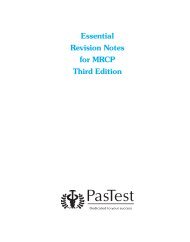OSCEs for Medical Students, Volume 3 Second Edition
OSCEs for Medical Students, Volume 3 Second Edition
OSCEs for Medical Students, Volume 3 Second Edition
You also want an ePaper? Increase the reach of your titles
YUMPU automatically turns print PDFs into web optimized ePapers that Google loves.
120 <strong>OSCEs</strong> <strong>for</strong> <strong>Medical</strong> <strong>Students</strong>, <strong>Volume</strong> 3AnswersCommentPaediatric cardiovascular examination should be straight<strong>for</strong>ward. The keys are to seeif the child is either cyanosed or in heart failure and if the child has a scar. If thechild is blue, there is a problem getting blood into the lungs. Most likely, the childhas Fallot’s tetralogy. If the child is tachypnoeic and pink (and does not haverespiratory disease), the child will be in heart failure and is likely to have a VSD orAVSD. Scars may be midline (implying a curative operation such as VSD closure orFallot’s repair) or subclavicular, suggesting a palliative systemic-pulmonary shunt or acoarctation resection.An alternative presentation will be a child with a murmur who is neither blue nortachypnoeic. This will either be an innocent or pathological murmur. Innocent ones donot radiate, are quiet and precordial and the child is otherwise well. Some alter withposition. If it is not innocent, the position where it is loudest gives a clue as to thecause and also its character. Those loudest below the nipples are pansystolic (VSD,Fallot’s, AVSD) and those above ejection systolic (PDA, AS, coarctation). In anexamination, never <strong>for</strong>get the femorals, the blood pressure or the weight.
















